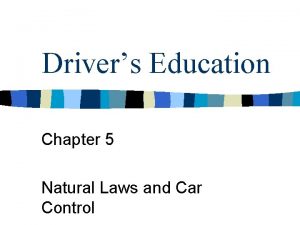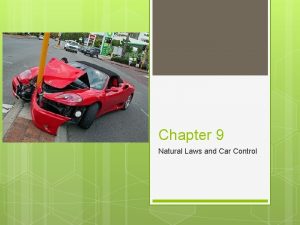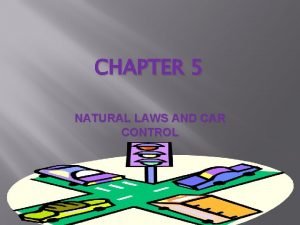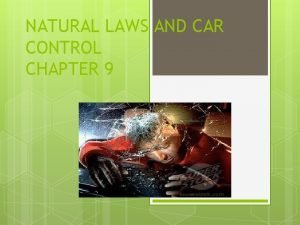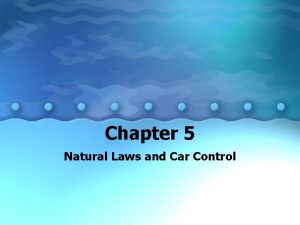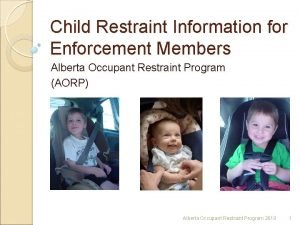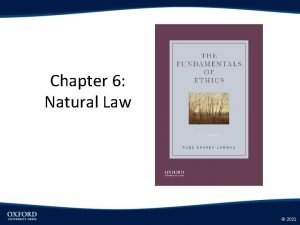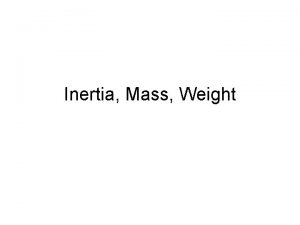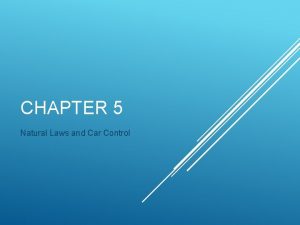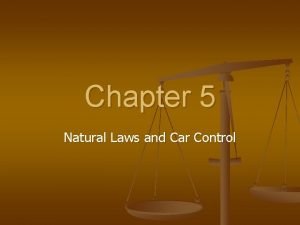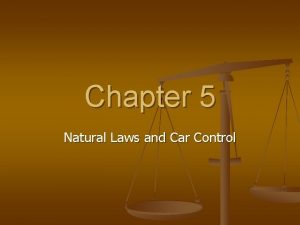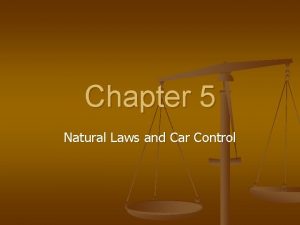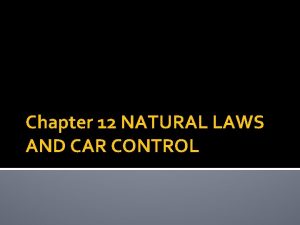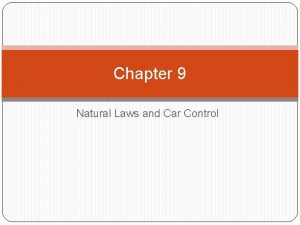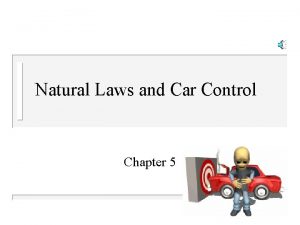Chapter 9 Natural Laws and Car Control Inertia













- Slides: 13

Chapter 9 Natural Laws and Car Control

Inertia, Momentum, and Energy of Motion • Inertia – objects that are at rest tend to stay at rest and objects in motion tend to stay in motion. You will feel this driving when braking, accelerating, and turning. • Momentum – the tendency of an object to stay in motion. Momentum is influenced by weight and speed. • Energy of Motion is called Kinetic Energy When a vehicles speed doubles – it takes 4 x the distance to stop When a vehicles speed triples – it takes 9 x the distance to stop • Gravity - the force that pulls things to Earth.


Tires and Traction • Friction – the force that keeps tires from sliding on the road. Heat is created when there is friction. • Traction - the tires grip on the road. Varies with road surfaces and conditions. • Tread - the grooved surface of the tires. Overinflated tires – too much air – tires grip in the center Underinflated tires – too little air – tires grip on the outside edges PSI – pounds per square inch – measures the amount of air pressure in tires Check PSI when you haven’t driven much because heat from driving them will raise air pressure. • Blowout - a sudden loss of air pressure.

• How tires grip and wear at different pressures.

Vehicle Balance 1. Vehicle balance is when the weight of the vehicle is distributed on the 4 tires. 2. Center of Gravity is the point around the vehicle that the weight of the vehicle is distributed equally.

Balance and Steering • Pitch - the tilting motion of a vehicle when you accelerate or brake too quickly.

Forces In Curves • When going through a curve, your vehicle wants to go straight due to inertia. 1. Sharpness in curves – the sharper the curve, the more traction you need. 2. Speed – the faster you go, the more traction you need. 3. Load – the ore weight you have, the more traction you need. 4. Shape of the road – a banked curve will help you drive safely through a curve. This is when the outside of the curve is higher than the inside. It helps to create better traction. ***Slow down before going into a curve!

Total Stopping Distance • This is from the time you see a hazard until you get stopped. The faster you are travelling, the longer it will take you to stop. Total Braking Distance • From the time you apply the brake until the time you get stopped. • Stopping distances video https: //www. youtube. com/watch? v=KGk. KDa. Yd 3 Mo

• Perception Time – the length of tie it takes for you to identify the hazard. • Perception Distance – the distance you travelled when you identify the hazard. • Reaction Time – the length of time you take to apply the brake. The average reactions time is 1. 6 seconds. At 60 mph you would travel 88 feet per second, which means you travel 124 feet before you even put your foot on the brake. A very alert driver can react in up to ¾ of a second. • Reaction Distance – distance you travel while you react. This is only while you react – your stopping distance would be more.

Force of Impact • This is how hard something gets hit – It is affected by speed, weight, and time Speed – the faster the vehicle is going, the more damage it will cause. Weight – the heavier a vehicle is, the more damage it will cause. Time between impact and stopping – the energy created has to go somewhere – Is the object that gets hit going to give way like bushes or not give way – like a concrete wall. https: //www. youtube. com/watch? v=v 9 ML 4 GA 47 Rg

Safety Belts and Other Safety Features • Active Restraints – a device the driver or passengers have to engage. Safety Belts • Passive Restraints – a device that works automatically Air Bags • Child Safety Seats – required in all states up to a specific weight and age of the child. • Crush Zones – areas around the vehicle that will crumple to protect the passengers inside the vehicle (as seen on previous slide’s video) • Energy Absorbing Bumbers • Side Impact Panels • Penetration resistant windshields – thin layer of plastic between two layers of glass – helps shattered window glass from going all over. • Head Restraints – to help with whiplash injuries

Chapter 9 Review • Page 179 – Vocab • Page 180 – discussion questions • Page 181 – multiple choice
 Chapter 5 natural laws and car control worksheet answers
Chapter 5 natural laws and car control worksheet answers Natural laws and car control chapter 9
Natural laws and car control chapter 9 Chapter 5 natural laws and car control
Chapter 5 natural laws and car control A vehicle's momentum depends on its
A vehicle's momentum depends on its Chapter 5 natural laws and car control
Chapter 5 natural laws and car control If car a passes car b, then car a must be ____.
If car a passes car b, then car a must be ____. A 1000 kg car and a 2000 kg car is hoisted the same height
A 1000 kg car and a 2000 kg car is hoisted the same height Facts about montesquieu
Facts about montesquieu Alberta car seat regulations
Alberta car seat regulations Car 2 car communication consortium
Car 2 car communication consortium Natural law ethics
Natural law ethics What are natural laws
What are natural laws What is virtue ethics
What is virtue ethics Natural capital and natural income
Natural capital and natural income
